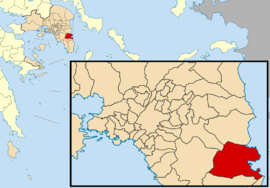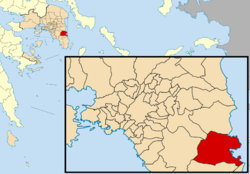Markopoulo Mesogaias: Difference between revisions
KaragouniS (talk | contribs) Cited additional sources for the history section Tags: Reverted Disambiguation links added |
KaragouniS (talk | contribs) Tag: Reverted |
||
| Line 58: | Line 58: | ||
In 1914 Markopoulo became a commune. The change was made with the Royal Decree D. 31.08.1912 Government Gazette A262/1912 and included the settlements: Markopoulo, Dagla, Porto Rafti, Agios Spyridon, Prasa, [[Brauron|Vraona]], while in 1953 Porto Rafti was renamed to Limenas Messogeas.<br> |
In 1914 Markopoulo became a commune. The change was made with the Royal Decree D. 31.08.1912 Government Gazette A262/1912 and included the settlements: Markopoulo, Dagla, Porto Rafti, Agios Spyridon, Prasa, [[Brauron|Vraona]], while in 1953 Porto Rafti was renamed to Limenas Messogeas.<br> |
||
The first President of the Markopoulo Commune was elected on 9 February 1914, George Sotiriou Nikolaou, also called "grammatikos", followed by twelve others, until 1965, when Markopoulo became a municipality again.<br> |
The first President of the Markopoulo Commune was elected on 9 February 1914, George Sotiriou Nikolaou, also called "grammatikos", followed by twelve others, until 1965, when Markopoulo became a municipality again.<br> |
||
<ref> {{cite web|url=https://www.markopoulo.gr/i-poli/istoria/|publisher=Official site of the Municipality of Markopoulo|title=ΙΣΤΟΡΙΑ ΤΟΥ ΔΗΜΟΥ ΜΑΡΚΟΠΟΥΛΟΥ ΜΕΣΟΓΑΙΑΣ ΑΤΤΙΚΗΣ-HISTORY OF THE MUNICIPALITY OF MARKOPOULO MESSOGEAS, ATTICA) |language=el}</ref> |
<ref> {{cite web|url=https://www.markopoulo.gr/i-poli/istoria/ |publisher= Official site of the Municipality of Markopoulo|title=ΙΣΤΟΡΙΑ ΤΟΥ ΔΗΜΟΥ ΜΑΡΚΟΠΟΥΛΟΥ ΜΕΣΟΓΑΙΑΣ ΑΤΤΙΚΗΣ-HISTORY OF THE MUNICIPALITY OF MARKOPOULO MESSOGEAS, ATTICA) |language=el}</ref> |
||
<ref>{{cite book |last1= Vlachopoulos|first1= Andreas |last2= Kakavogianni|first2= Olga |last3= Matthaiou |first3= Angelos |date= 2017 |last4= Valavanis |first4= Panos |last5= Palaiokrassa-Kopitsa |first5= Lydia |title= Athens and Attica History and Archaeology |url=https://www.academia.edu/33833408/A_Vlachopoulos_ed_Athens_and_Attica_History_and_Archaeology_Melissa_Publishing_House_Athens_2017 |location= |publisher= Melissa Publishing House|page= |isbn=9789602043370}}</ref> <ref>{{cite book |last1= Steinhauer |first1= George |last2 = Gini-Tsofopoulou |first2= Eleni|title= Μουσείο: Ιστορία και πολιτισμός των Μεσογείων Αττικής |url=https://biblionet.gr/titleinfo/?titleid=173316&return_url|location= Athens |date= 2009 |publisher= Διεθνής Αερολιμένας Αθηνών "Ελευθέριος Βενιζέλος" |page= |isbn=}}</ref> <ref>{{cite book |last= Μεθενίτης |first= Σταμάτης Δημ.|author-link= |date= 2007 |title= Το Μαρκόπουλο των Μεσογείων : Οδοιπορικό στους αιώνες|url= https://catalogue.nlg.gr/Record/b.421962 |location= Markopoulo |publisher= Liberis Publications|isbn=}}</ref> |
<ref>{{cite book |last1= Vlachopoulos|first1= Andreas |last2= Kakavogianni|first2= Olga |last3= Matthaiou |first3= Angelos |date= 2017 |last4= Valavanis |first4= Panos |last5= Palaiokrassa-Kopitsa |first5= Lydia |title= Athens and Attica History and Archaeology |url=https://www.academia.edu/33833408/A_Vlachopoulos_ed_Athens_and_Attica_History_and_Archaeology_Melissa_Publishing_House_Athens_2017 |location= |publisher= Melissa Publishing House|page= |isbn=9789602043370}}</ref> <ref>{{cite book |last1= Steinhauer |first1= George |last2 = Gini-Tsofopoulou |first2= Eleni|title= Μουσείο: Ιστορία και πολιτισμός των Μεσογείων Αττικής |url=https://biblionet.gr/titleinfo/?titleid=173316&return_url|location= Athens |date= 2009 |publisher= Διεθνής Αερολιμένας Αθηνών "Ελευθέριος Βενιζέλος" |page= |isbn=}}</ref> <ref>{{cite book |last= Μεθενίτης |first= Σταμάτης Δημ.|author-link= |date= 2007 |title= Το Μαρκόπουλο των Μεσογείων : Οδοιπορικό στους αιώνες|url= https://catalogue.nlg.gr/Record/b.421962 |location= Markopoulo |publisher= Liberis Publications|isbn=}}</ref> |
||
Revision as of 15:33, 8 October 2023
Markopoulo Mesogaias
Μαρκόπουλο Μεσογαίας | |
|---|---|
Settlement | |
 | |
| Coordinates: 37°53′N 23°56′E / 37.883°N 23.933°E | |
| Country | Greece |
| Administrative region | Attica |
| Regional unit | East Attica |
| Government | |
| • Mayor | Kostas Allagiannis (since 9/2019) |
| Elevation | 80 m (260 ft) |
| Time zone | UTC+2 (EET) |
| • Summer (DST) | UTC+3 (EEST) |
| Postal code | 190 03 |
| Area code(s) | 22990 |
| Vehicle registration | Z |
| Website | www.markopoulo.gr |
Markopoulo Mesogaias (Greek: Μαρκόπουλο Μεσογαίας) is a town and a municipality in East Attica, Greece. The municipality has an area of 81.844 km2 (31.600 sq mi).[2]
Geography
The municipality Markopoulo Mesogaias is situated in the Mesogaia plain, in the eastern part of the Attica peninsula, and touches the Aegean Sea coast in the east, where the port town Porto Rafti is located. The town Markopoulo is in the western part of the municipality, at about 80 m (260 ft) elevation. It is 5 km (3.1 mi) north of Kalyvia Thorikou, 6 km (3.7 mi) east of Koropi and 21 km (13 mi) southeast of Athens city centre. Greek National Road 89 (Gerakas - Koropi - Lavrio - Sounio) passes through Markopoulo. Athens International Airport is 4 km (2.5 mi) north of the town. Markopoulo had a railway station on the Athens–Lavrion Railway, which closed for passenger traffic in 1957.
Settlements
- Agía Triáda (2011 census pop. 218)
- Vravróna, ancient Brauron (pop. 195) - located in the northeast by the Aegean Sea
- Chamoliá (pop. 185)
- Koulidás (pop. 243)
- Markópoulo (pop. 9,513) - the municipal seat
- Poriá (pop. 0)
- Porto Rafti or Limín Markopoúlou (pop. 9,686)
History
Markopoulo occupies the central part of Southeast Attica and forms with Spata, Peania, Koropi and part of the area of Kalyvia, the valley of Mesogeia, with natural outlets to the east the coastal areas of Vravrona and Porto Rafti.
Recent archaeological investigations in the area of the Olympic Equestrian Centre show a continuous human presence from the Stone Age to the present day.
In the 'Mythical Times' there are references to a number of centres scattered in the area of present-day Markopoulo, with reference to the Myrrhenian King Colinus, the "descendant of Hermes", to have lived "before Kekropos" where Merenda Mount is located today.
During the historical period, Myrrinous (today's Merenda), Prasies (Prasa or Brasa), Steria (Drivlia), Kytheros (Ligori), Angeli (Angelisi), Filaid (Vraona), together with the Sanctuary of Artemis in Vraona, were the municipalities located in the present-day area of Markopoulo, where, together with the other 168 "Cleisthenian municipalities", they constituted the Athenian territory during the time of the cosmocracy of Athens.
In the Roman times, the place fell into decline, culminating in the Byzantine period, when what was left of the ancient monuments was destroyed. The area of present-day Markopoulo, like the whole of Attica, would be lost to the Byzantines long before the Turks overthrew the empire. Thus, in the 13th century, the French dukes Guy II de la Roche and Othon de la Roche will dominate the place, leaving a legacy of two monuments to mark the site.
It was a combination of a castle-vigla watchtowers to control key points in the areas where they were located and to transmit visual messages. In the 14th century, Catalans would become masters of the area for seventy years, imposing perhaps the most brutal terror that Attica had ever known, while in the late 14th and half of the 15th century the Florentine Acciaioli family would become masters of the place.
In the 14th century, the Catalans would become masters of the area for seventy years, imposing perhaps the most brutal terror that Attica had ever known, while in the late 14th and half of the 15th century the Florentine Acciaioli family would become masters of the area.
The influence of the latter was a catalyst for this place, since they were the ones who invited Albanian-speaking continental tribes of Greek origin, who lived in the area of northern Epirus between Mount Tomaros and the river Genoussos, to settle the then deserted Attica.
In the area of today's Markopoulo, the family of Ioannis Markopoulos settled in the area around 1420, creating the village of "Ioannis Markopoulos", as can be seen from the Sanjak of Eğriboz, a Turkish tax document of 1506 AD, which shows that a hundred years after the first settlement, there are 23 dwellings in the village, most of which are inhabited by families bearing the surname Markopoulos.
Therefore, the Arvanites along with the few indigenous people created the present-day Markopoulo.
Markopoulo, along with all of Attica, will fall into the hands of the Turks in 1456, following its fate, during the 400 years of the Turkish yoke.In the Greek War of Independence, more than 35 Markopoulo locals participated (from the data available so far).
During the Ottoman rule and until the end of the administration of our country by Ioannis Kapodistrias, the power in Markopoulo was exercised by the annually elected Demogerontas. Fortunately, a document has survived in which "the inhabitants of the village universally" elected a caretaker Demogerontas Anastas Apostolis (Souliotis) for the year 1830.
In 1840 we find Markopoulo belonging to the Municipality of Kekropia, which came from the merger of the Municipality of Arafinos with the Municipality of Myrrinountos (Liopesi), while two years later the Municipality of Kekropia was renamed to the Municipality of Kropia with its seat in Koropi.
In 1847 Markopoulo became the capital of the Municipality of Kropia with Royal Decree and then Markopoulo became the capital of the Municipality of Markopoulo in 1847, having the following areas under control: Dagla, Porto - Rafti, Agios Spyridon, Prasa, Kurouni, Raftopoula, Vraona, Alykos, Fleves, Patroklu, Aspronisia, Kokkinonisia, Pikermi.
So from 1847 until the abolition of the Municipalities and the reconstitution of the Communities, which took place with the Law DNZ/1912 of Eleftherios Venizelos, in 1914 the capital of the Municipality of Kropias was Markopoulo.
In 1914 Markopoulo became a commune. The change was made with the Royal Decree D. 31.08.1912 Government Gazette A262/1912 and included the settlements: Markopoulo, Dagla, Porto Rafti, Agios Spyridon, Prasa, Vraona, while in 1953 Porto Rafti was renamed to Limenas Messogeas.
The first President of the Markopoulo Commune was elected on 9 February 1914, George Sotiriou Nikolaou, also called "grammatikos", followed by twelve others, until 1965, when Markopoulo became a municipality again.
[3]
[4] [5] [6]
Historical monuments
- The church of Saint Paraskevi, in 1741 (Markopoulo-Mesogeia). A wall painting monument (1741) of George Markou the Argus, the great and prolific post-Byzantine ecclesiastic iconographer of the 18th century ("....La Santa Parascevi (inizio della sua agiografia1741׃ ,(che si trova al paesimo di Marcopulo, dell 'Attica...." Evangelos Andreou http://ketlib.lib.unipi.gr/xmlui/handle/ket/849)[7]
- The church of Saint Thecla. A wall painting monument (18th century) of "Georgios Markou the Argeius" iconographers school http://www.biblionet.gr/book/178713/Ανδρέου,_Ευάγγελος/Γεώργιος_Μάρκου_ο_Αργείος
- The Temple of Artemis in Brauron
Sports
Markopoulo was the home to two venues of the 2004 Summer Olympics: the Markopoulo Olympic Equestrian Centre and the Markopoulo Olympic Shooting Centre.
Markopoulo's women volleyball team plays in the A1 Ethniki Women's Volleyball, the highest level national competition.
| Sport clubs based in Markopoulo | |||
|---|---|---|---|
| Club | Founded | Sports | Achievements |
| Marko F.C. | 1927 | Football | Earlier presence in Gamma Ethniki |
| Markopoulo Athletic Club - AOM | 1988 | Volleyball | Presence in A1 Ethniki women volleyball |
Economy
Historically, the economy of the region has been largely agricultural, with grapes and wine being the major components of the local economy until today. The Merenda quarry also allowed for a major economic expansion during the 1990s, however operations have ceased since 2014. Today, tourism is a major driver as the nearby seaside town, Porto Rafti, is a very popular tourist destination in Attica.
Multiple companies, including SkyGreece Airlines have had their corporate headquarters in Markopoulo Mesogaias due to the easy access to Athens International Airport.
Historical population
| Year | Population |
|---|---|
| 1981 | 9,388 |
| 1991 | 14,499 |
| 2001 | 15,608 |
| 2011 | 20,040 |
| 2021 | 21,284 |
See also
References
- ^ "Αποτελέσματα Απογραφής Πληθυσμού - Κατοικιών 2021, Μόνιμος Πληθυσμός κατά οικισμό" [Results of the 2021 Population - Housing Census, Permanent population by settlement] (in Greek). Hellenic Statistical Authority. 29 March 2024.
- ^ "Population & housing census 2001 (incl. area and average elevation)" (PDF) (in Greek). National Statistical Service of Greece. Archived from the original (PDF) on 2015-09-21.
- ^ {{cite web|url=https://www.markopoulo.gr/i-poli/istoria/ |publisher= Official site of the Municipality of Markopoulo|title=ΙΣΤΟΡΙΑ ΤΟΥ ΔΗΜΟΥ ΜΑΡΚΟΠΟΥΛΟΥ ΜΕΣΟΓΑΙΑΣ ΑΤΤΙΚΗΣ-HISTORY OF THE MUNICIPALITY OF MARKOPOULO MESSOGEAS, ATTICA) |language=el}
- ^ Vlachopoulos, Andreas; Kakavogianni, Olga; Matthaiou, Angelos; Valavanis, Panos; Palaiokrassa-Kopitsa, Lydia (2017). Athens and Attica History and Archaeology. Melissa Publishing House. ISBN 9789602043370.
- ^ Steinhauer, George; Gini-Tsofopoulou, Eleni (2009). Μουσείο: Ιστορία και πολιτισμός των Μεσογείων Αττικής. Athens: Διεθνής Αερολιμένας Αθηνών "Ελευθέριος Βενιζέλος".
- ^ Μεθενίτης, Σταμάτης Δημ. (2007). Το Μαρκόπουλο των Μεσογείων : Οδοιπορικό στους αιώνες. Markopoulo: Liberis Publications.
- ^ ".:BiblioNet : Γεώργιος Μάρκου ο Αργείος / Ανδρέου, Ευάγγελος". www.biblionet.gr. Retrieved 2018-11-16.
External links



